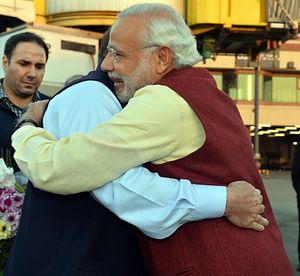Late last week, on Christmas day, pictures flooded both mainstream and social media of Indian Prime Minister Narendra Modi and his Pakistani counterpart Nawaz Sharif walking hand-in-hand in Lahore. This was a surprise for observers of international affairs in South Asia, catching even many bureaucrats and officials in New Delhi and Islamabad off-guard. According to various reports, the story goes that Modi accepted an invitation to visit Lahore after speaking with Sharif to wish him well on his birthday. Within hours, Modi had touched down in Lahore, becoming the first Indian prime minister since Atal Behari Vajpayee in 1999 to visit the city. Additionally, Modi’s visit made him the first Indian premier to visit Pakistan since 2004.
Per The Hindu, the entire visit was over in a matter of hours. Despite the relatively brief length of Modi’s stopover in Lahore, the incident set the media in both countries ablaze, with frenzied commentary speculating on whether this visit meant that the prospect of renewed comprehensive peace talks was more serious than it had been at any other point in the two rivals’ shared 67 year history. Indeed, it’s difficult to look at the photographs that came out of Modi’s Lahore visit and not sense just how remarkable they are. The two leaders are seen walking hand-in-hand, both grinning. There is a sense that Modi and Sharif, more so than any two concurrent Indian and Pakistani leaders in a long time, have a positive personal rapport.
As with any brief moment of goodwill in the India-Pakistan bilateral situation, a heavy dose of realism is warranted. Though the imagery out of Lahore is striking and the broader recent rapprochement encouraging, history reminds us that this bilateral is prone to repeated and unpredictable backsliding. Critics in both India and Pakistan were quick to point this out last week. In India, many noted that Nawaz Sharif is perhaps the wrong focus point for Modi’s outreach because, after all, in Pakistan, the real power rests with the chief of army staff, General Raheel Sharif (no relation to the prime minister).
Interestingly, reports suggest that Pakistan’s army was involved in facilitating and clearing the path for the Lahore encounter to take place in the first place. In late October, Lt. Gen. Nasir Khan Janjua became Pakistan’s national security adviser, replacing Sartaj Aziz. Janjua’s appointment suggests that, more than ever since Pakistan’s May 2013 elections, the army and civilian government have come together on the country’s foreign and security policy, which includes outreach to India. What would convince the Pakistani army to acquiesce to a broader rapprochement at this point? Reuters suggests that U.S. pressure during Gen. Sharif’s recent trip to Washington played a part as well (indeed, making good with India could have been linked to any prospects of a ‘nuclear deal’ with Pakistan in recent talks).

































